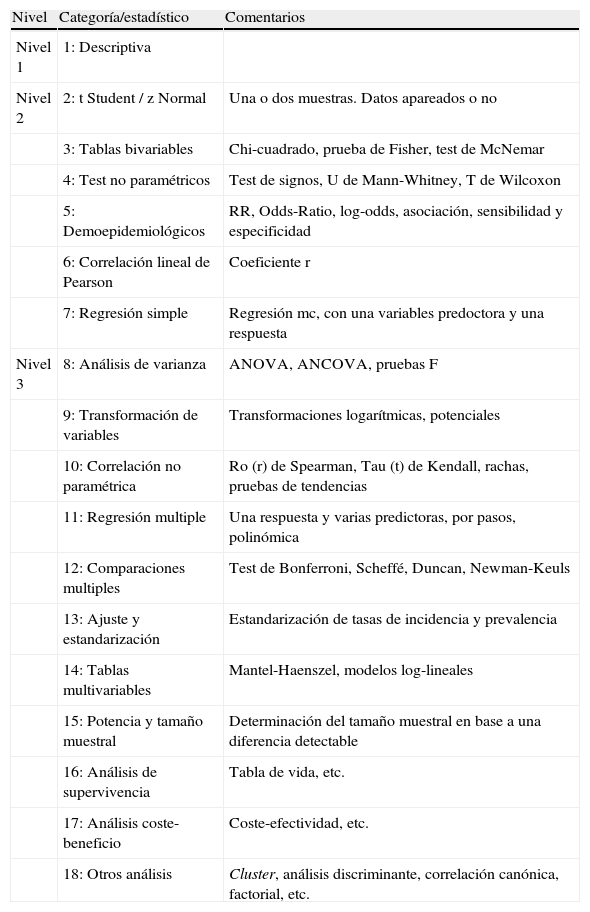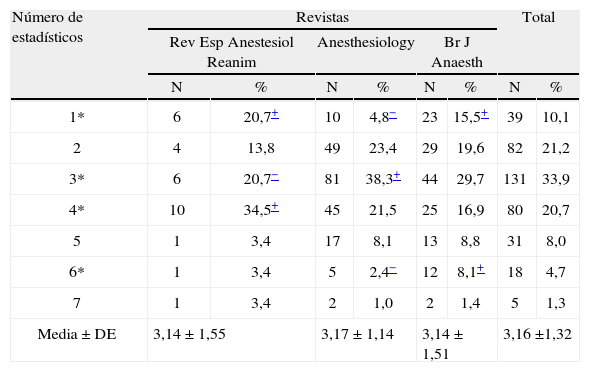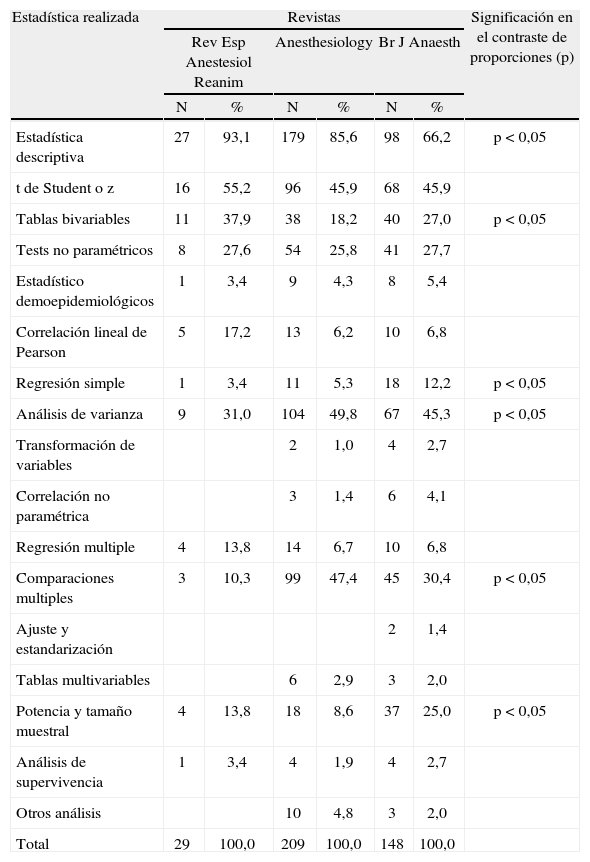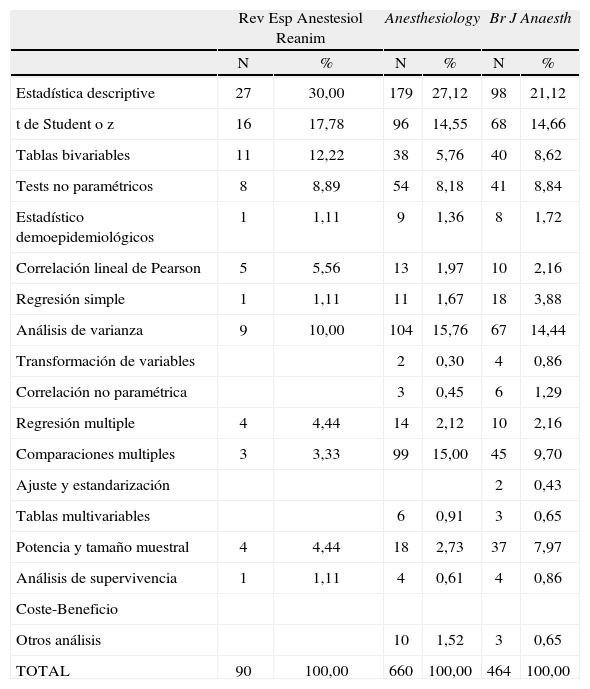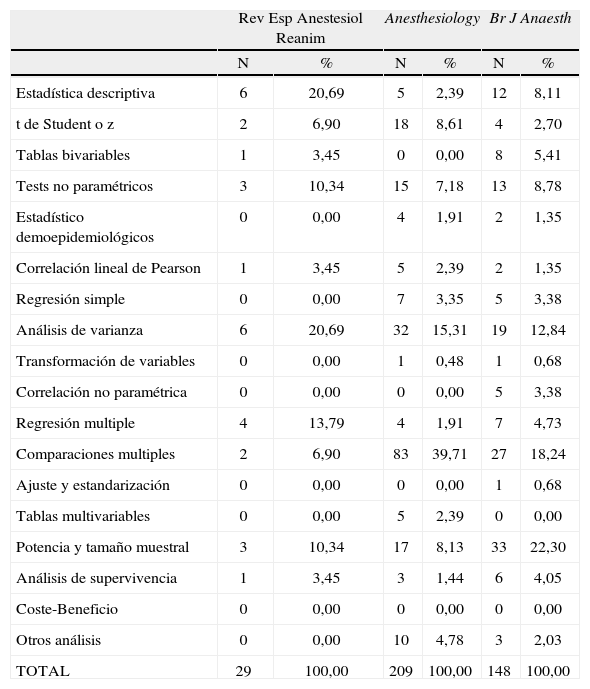Conocer la utilización de distintas pruebas estadísticas y el grado de accesibilidad análisisdependiente y artículo-dependiente en revistas de impacto en Anestesiología según el Science Citation Index (SCI) en relación con la Revista Española de Anestesiología y Reanimación (REDAR).
Material y MétodosSe analizaron los artículos originales publicados durante 2004, en tres revistas seleccionadas: Anesthesiology, British Journal of Anaesthesia y Revista Española de Anestesiología y Reanimación, registrando 1.214 pruebas estadísticas en 386 artículos originales de 412 analizados, ya que 26 originales no utilizaron estadística.
ResultadosEl porcentaje de artículos con estadística fue del 93,7%. El número de estadísticos total por artículo fue de 3,16 (1,32) [media (desviación estándar)].
DiscusiónSe aprecia que un lector que sólo comprenda estadística descriptiva, será capaz de entender una cuarta parte de los análisis estadísticos usados en los artículos estudiados, independientemente de la revista estudiada. Un lector familiarizado con estadística de Segundo Nivel (Clasificación de Emerson y Colditz), entenderá globalmente, desde el punto de vista estadístico, el 61,94%, siendo este porcentaje más elevado para REDAR, del 76,67%.
ConclusionesComo consecuencia del gran progreso en la utilización de la estadística en las revistas en Anestesiología, nos encontramos ante un incremento en los últimos años en el uso de estadística de alto nivel. Esta circunstancia obligará a obtener y mejorar los conocimientos sobre estadística para una mejor comprensión de la metodología de los artículos originales de las publicaciones científicas. Los resultados obtenidos respecto de la accesibilidad análisis-dependiente demuestran que la Revista Española de Anestesiología y Reanimación es de más fácil comprensión por lectores con nivel de conocimiento estadístico medio, y que tanto Anesthesiology como British Journal of Anaesthesia publican artículos que usan pruebas de mayor complejidad.
To determine the use of various statistical analyses and the degree of analysis-dependent and article-dependent accessibility to the reader of publications in anesthesiology journals with impact factors (included in the Science Citation Index) in comparison with Revista Española de Anestesiología y Reanimación.
Material and MethodsWe analyzed original articles published in 2004 by 3 journals: Anesthesiology, the British Journal of Anaesthesia, and the Revista Española de Anestesiología y Reanimación. We found 1214 instances of use of statistics in 386 of the 412 articles analyzed. Twenty-six original articles did not use statistical analyses.
ResultsStatistics were used in 93.7% of the articles. The mean (SD) number of statistical tests used per article was 3.16 (1.32). Readers able to understand only descriptive statistics would find only a quarter of the articles' analyses comprehensible in all 3 of the journals studied. A reader familiar with second-level statistics (after the classification of Emerson and Colditz), would have an overall understanding of the analyses in 61.94% of the articles. Such a reader would be able to understand a higher percentage (76.67%) of articles in the Spanish anesthesiology journal.
ConclusionsAs a result of marked advances in the use of statistics in anesthesiology journals, readers are seeing more applications of higher-level statistics. Readers must therefore acquire greater knowledge of statistics in order to understand the methods used in original research publications. The results we report for analysis-dependent accessibility show that Revista Española de Anestesiología y Reanimación is easier to understand for readers with knowledge of middle-level statistics. BothAnesthesiology and the British Journal of Anaesthesia publish articles that apply more complex statistical analyses.
Artículo
Comprando el artículo el PDF del mismo podrá ser descargado
Precio 19,34 €
Comprar ahora









